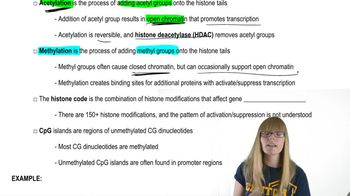Identical twins each carry the same genome, but over time, can develop different phenotypes. How can you explain this?
Table of contents
- 1. Introduction to Genetics51m
- 2. Mendel's Laws of Inheritance3h 37m
- 3. Extensions to Mendelian Inheritance2h 41m
- 4. Genetic Mapping and Linkage2h 28m
- 5. Genetics of Bacteria and Viruses1h 21m
- 6. Chromosomal Variation1h 48m
- 7. DNA and Chromosome Structure56m
- 8. DNA Replication1h 10m
- 9. Mitosis and Meiosis1h 34m
- 10. Transcription1h 0m
- 11. Translation58m
- 12. Gene Regulation in Prokaryotes1h 19m
- 13. Gene Regulation in Eukaryotes44m
- 14. Genetic Control of Development44m
- 15. Genomes and Genomics1h 50m
- 16. Transposable Elements47m
- 17. Mutation, Repair, and Recombination1h 6m
- 18. Molecular Genetic Tools19m
- 19. Cancer Genetics29m
- 20. Quantitative Genetics1h 26m
- 21. Population Genetics50m
- 22. Evolutionary Genetics29m
13. Gene Regulation in Eukaryotes
Epigenetics, Chromatin Modifications, and Regulation
Problem 7
Textbook Question
Describe how reversible chemical changes to DNA and histones are linked to chromatin modification.
 Verified step by step guidance
Verified step by step guidance1
Begin by defining chromatin as the complex of DNA and proteins, mainly histones, that package DNA into a compact, organized structure within the nucleus.
Explain that reversible chemical changes, also known as epigenetic modifications, occur on DNA (such as DNA methylation) and histone proteins (such as acetylation, methylation, phosphorylation).
Describe how these chemical modifications alter the interaction between DNA and histones, affecting chromatin structure by either loosening (euchromatin) or tightening (heterochromatin) the DNA packaging.
Discuss that these changes are reversible because specific enzymes can add or remove these chemical groups, allowing dynamic regulation of gene accessibility and expression.
Conclude by linking these reversible modifications to chromatin remodeling, which controls gene expression by regulating how tightly DNA is wound around histones, thus influencing cellular function and identity.
 Verified video answer for a similar problem:
Verified video answer for a similar problem:This video solution was recommended by our tutors as helpful for the problem above
Video duration:
1mPlay a video:
Was this helpful?
Key Concepts
Here are the essential concepts you must grasp in order to answer the question correctly.
Epigenetic Modifications
Epigenetic modifications refer to reversible chemical changes to DNA or histone proteins that affect gene expression without altering the DNA sequence. These changes include DNA methylation and histone modifications, which regulate chromatin structure and accessibility, influencing whether genes are active or silenced.
Recommended video:
Guided course

Histone Protein Modifications
Histone Modifications
Histone modifications involve the addition or removal of chemical groups such as acetyl, methyl, or phosphate groups to histone tails. These reversible changes alter chromatin compaction, either loosening it to promote gene expression or tightening it to repress transcription, thus playing a key role in chromatin remodeling.
Recommended video:
Guided course

Histone Protein Modifications
Chromatin Structure and Gene Regulation
Chromatin is the complex of DNA and histone proteins that packages genetic material in the nucleus. Its structure can be dynamically modified by chemical changes, which influence gene accessibility. Open chromatin (euchromatin) is associated with active transcription, while closed chromatin (heterochromatin) is linked to gene repression.
Recommended video:
Guided course

Chromatin
Related Videos
Related Practice
Textbook Question
643
views


